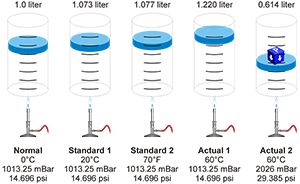One of the most common questions I am asked when working with customers is, “What is the difference between a Standard Liter, a Normal Liter and an Actual Liter?” Even the fact that one liter is not always one liter causes confusion. So, let me try to explain these differences with the hopes of increasing your understanding.
Mass Units vs. Volume Units
Different from technical mass units, a technical volume unit always depends on ambient conditions. We are all familiar with the situation – you’re in an airplane and want to drink a cup of coffee. The flight attendant brings you coffee and creamer. What happens when you open the creamer? Most likely, some of the creamer will spill on your clothes. The sealed creamer cup and the gas inside of it are filled on the ground (sea level) with an ambient pressure of 1013.25 mBar. But, when you open the sealed creamer cup in an airplane 30,000 feet above sea level, the ambient pressure is much lower than on ground level and in your creamer cup. The covered air can escape and some drops of creamer will do the same. Where else would you expect to find those drops, except on you and your clothes.
But why does this happen? The volume of the sealed creamer cup did not change between ground and flight level, but the ambient pressure on it went down. The molecules have more space to flip around and want to use this extra space.
Which Standard Are We Referencing?
Let’s go back to earth and look at our measuring technology.
 Normal vs. Standard vs. Actual Liter
Normal vs. Standard vs. Actual Liter
We put 1 liter of air at 0° C and sea level 1013.25 mBar in a cylinder. This is called “Normal Flow”. When the temperature is raised to 20°C, the molecules need more space. The piston will go up and the volume increases to 1.073 liters - exactly 7.3%. This is called “Standard Flow.” However, you can imagine that there are a lot of different standards in the world. In Europe, the “Standard” is defined at 20°C. In the United States, the Farenheit temperature scale is used so 70°F is standard, which is 21.1°C. NASA uses a 60°F standard and China uses 15°C. The most important thing is to know which standard we are referencing.
If temperature or ambient pressure differs from these standards and normal conditions, we are talking about “Actual Flow”. Actual flow can be gas at 100°F or a measurement at the top of a mountain.
Brooks Instruments experts will always help you define your standard so you can be sure to get an optimized solution for your measurement challenge and application.
Contact our applications engineers today.